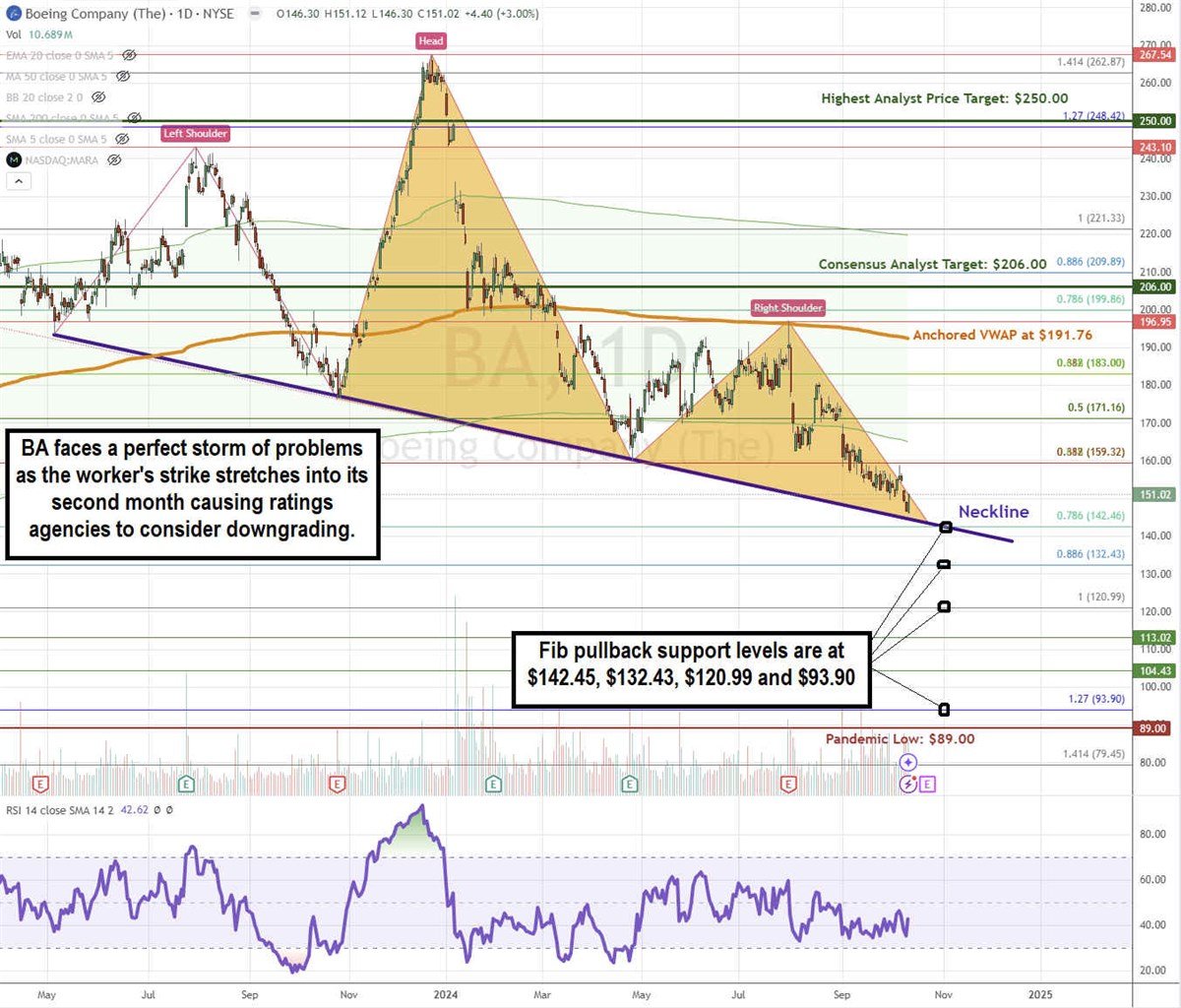
The world's largest manufacturer of airplanes, The Boeing Co. (NYSE: BA), can't seem to catch a break; following Murphy's Law, everything that can go wrong did. In Boeing’s case, trouble with the Federal Aviation Administration (FAA) concerning safety compliance and production issues, financial issues threatening a rating agency downgrade, swelling debt of nearly $60 billion and strike negotiations with its 33,000 machinists hitting a dead end.
To add a cherry on top, Boeing just announced even larger losses for its third quarter of 2023 and plans to lay off 17,000 workers. With the aerospace sector giant's stock near two-year lows, long-term risk-averse investors may view this as a rare buying opportunity when sentiment is near all-time lows. While its problems read like a laundry list, it also underscores and itemizes the potential catalysts for recovery.
The Strike Negotiations Come to a Halt
Production halts for its high margin 737 MAX airplanes, 777X, and 767 programs commenced on Sept. 13, 2024, when nearly 33,000 workers and members of the International Association of Machinists and Aerospace Workers (IAM) union walked off the job, striking against unfair labor practices. Negotiations had Boeing increase wage proposals from 25% to 30% over four years with a restatement of bonuses and improvements to healthcare and retirement benefits. Workers are asking for a 40% wage hike and reinstatement of its scrapped defined-benefit pension. Boeing stated it withdrew its offers since further negotiation attempts made no sense. The fears of a prolonged strike lasting through 2024 have caused ratings agencies to warn of a downgrade.
S&P Places Boeing on CreditWatch Negative
Standard and Poor's (S&P) placed Boeing on CreditWatch Negative stemming from strike-related financial risk on Oct. 8, 2024. S&P estimates Boeing will incur a $10 billion cash outflow in 2024 due to working capital building needed to support its manufacturing process overhaul and strike-associated costs. The agency believes Boeing will need to raise cash to fund operations and working capital and meet debt maturities. Its BBB- issuer credit, senior unsecured debt, A-3 short-term and commercial paper ratings were placed on CreditWatch with negative implications.
A CreditWatch listing raises the likelihood of a downgrade if the strike continues through the end of 2024 if the company can’t raise sufficient capital to increase its financial leverage. Moody’s and Fitch also warned of downgrades with a prolonged strike.
Boeing’s debt rose to nearly $60 million after issuing $10 billion in debt in May. Boeing has to decide how it will raise cash and whether it will further dilute shareholders with preferred stock or convertible bond offerings.
Boeing Pre-Announces Revenue Warning for Q3 2024
On Oct. 11, 2024, Boeing pre-announced it will recognize $5 billion of charges and changes to programs across its Commercial Airplanes and Defense, Space & Security divisions when it reports Q3 2024 earnings results on Oct. 23, 2024. Boeing used up $1.3 billion of cash and racked up GAAP losses of $9.97 per share in the third quarter.
The Commercial Airplanes segment will incur a $3 billion pre-earnings charge on its 777X and 767 programs. It will also conclude production of the 767 freighters in 2027 (after delivering the remaining planes), recognizing a $400 million pre-tax charge reflecting the impact of the IAM strike. Its Boeing Defense, Space & Security (BDS) segment will recognize pre-tax earnings charges of $2 billion on the KC-46A, T-7A, Commercial Crew, and MQ-25 programs. Revenue guidance was cut to $17.8 billion versus $18.49 billion consensus estimates.
Boeing plans to cut 10% of its workforce or 17,000 employees, including executives, managers and workers. Incidentally, Boeing isn't allowed to fire strikers, and the strike is still in place. Its 777X deliveries have been extended to 2026 due to the strikes.
Can Things Be So Bad They’re Good for the Stock?
With third-quarter of 2024 earnings due out premarket on Oct. 23, 2024, investors may want to wait for the report. Even though they pre-announced lower revenue guidance for the upcoming quarter, the impact on its fourth quarter and the decision on how to raise cash has yet to be revealed. The new CEO, Kelly Ortberg, formerly of Rockwell Collins, only took office just over two months ago.
Despite all its problems, the company is a duopoly with Airbus. The company delivered just 33 planes in September, which was seven less than in August. Even Southwest Airlines Co. (NYSE: LUV), with a fleet of just Boeing 737 planes, has to wait for delivery even if the delivery schedule is extended.
Boeing continues to gain contracts as the only American airplane manufacturer in town, or country in this case. Boeing’s defense contracts surged 40% YoY to $34 billion. However, its fixed-price contracts on next-generation programs are losing money due to margin fluctuations despite strong demand for aircraft and bombs. Airlines still need new airplanes, so they have no choice but to wait out extended delivery schedules. Even the White House is trying to get the strike towards a conclusion as the Biden administration continues to pressure both sides toward an agreement.
The bar has been set low for its upcoming third-quarter earnings report. Guidance for the fourth quarter and full year 2024 is the wildcard and any conclusion to the strikes would be a positive catalyst that could slingshot shares higher.
BA Stock Is in a Head and Shoulders Pattern
A head-and-shoulders pattern is a bearish pattern comprised of three price peaks (left shoulder, head, and right shoulder), concluding with a breakdown through the neckline, which is formed by connecting the bottoms of each peak leg. A reversal can also trigger when the stock rallies through its right shoulder peak.

BA formed the left shoulder peak at $243.10, then the head peak at its highest swing high at $267.54, and the right shoulder peak at $196.96 near the daily anchored VWAP resistance. The neckline has been formed and triggers a breakdown under $142.46. The daily RSI has been chopping sideways around the 42-band. Fibonacci (Fib) pullback support levels are at $142.45, $132.43, $120.99, and $93.90.
Boeing’s average consensus price target is $206.00, and its highest analyst price target sits at $250.00. It holds 15 Buy ratings, seven Hold ratings, and two Sell ratings from analysts.
Actionable Options Strategies: Selling pressure has been steady on BA stock. It’s waiting on a capitulation bottom, which may trigger after the earnings report. Bullish investors can consider using cash-secured puts to buy BA at the fib pullback support levels for entry after its earnings report on Oct. 23, 2024.
Speculators looking for a large earnings reaction may consider a long straddle closer to the earnings release. Bullish investors looking for short-term upside can consider bull call debit spreads to limit capital and minimize the downside with capped upside.














